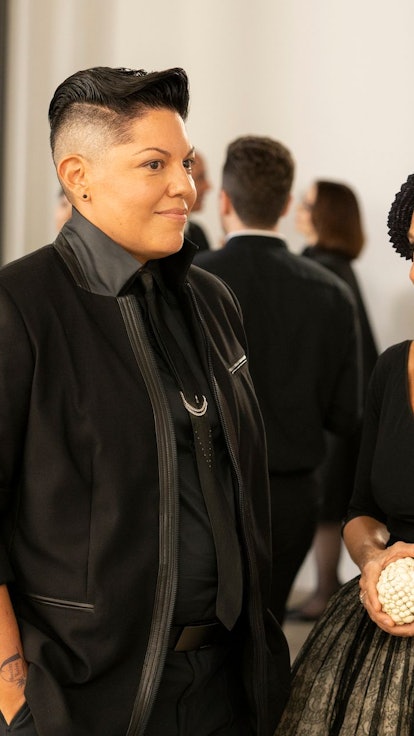During Sex and the City's original run, the show was critiqued for its whiteness, the characters' privilege, and its unabashed embrace of consumerism. The revival, And Just Like That, finds itself landing on the heels of a global pandemic, a racial reckoning, four years of an infamous president, the Me Too movement, and so much more.
Producers, writers, executives, and actors have all said that the show as it was wouldn’t make sense in 2021. So, as audiences clamor to catch up with Carrie, Miranda, and Charlotte, they're going to find not so much a new world, but a new context for what we have always loved.
Having seen the first two episodes, I can assure fans that the clothes are still fabulous, our three core characters still white, cisgender, and straight (for now), and the socioeconomic status still high. But there are attempts – some better than others – to right wrongs.
Here’s a rundown of just some of the ways the first two episodes of And Just Like That seek inclusivity.
- The new revival finds both Miranda and Carrie rocking their natural grey hair — Miranda more so than Carrie. The show goes out of its way to have Charlotte point this out, who is quickly rebuffed by Miranda, who points out that her work has nothing to do with her appearance. Charlotte, ever the pragmatist, notes that Ruth Bader Ginsburg dyed her hair to make it in a man’s world. It’s classic Sex and the City – feminism dissected from two vantage points.
- Conversations about hair don’t stop there. Miranda meets Dr. Naya Wallace, her new professor, and assumes she’s a student because she looks different than the picture she has seen. (Miranda fails to recognize the importance of ever-changing hair for Black women.) The back-to-back nature of these conversations allows for a nice reading of how the show for too long has been centered around white feminism. Let’s just say I’m Dr. Naya Wallace hive immediately.
- Speaking of Miranda, she's left her career in corporate law and is seeking a Masters in Human Rights. We’ve long known that Miranda is interested in justice (at least, when it comes to how she’s treated on dates), but we hear that she was enraged by the Muslim ban, attended the Women’s March (or at least bought a pussy hat), and is reading books focused on social justice. The show mines her scenes with her new teacher for awkward comedy, but it’s nice to see an honest representation of a white woman of a certain age attempting to change.
- Carrie may be facing significant life changes by the end of the first episode, but we also see she’s had a crash course in gender neutral language. In our first brunch scene back with the girls, she calls their server a “wait person.” I couldn’t help but wonder though, have Carrie’s views on bisexuality also evolved?
- Speaking of gender pronouns, Miranda quickly uses one in the classroom and is confronted by her classmate. It’s a terse moment, interestingly undercut when Dr. Wallace shuts the student down who is protesting labeling. I guess And Just Like That isn’t quite ready to let everyone speak yet.
- The first episode introduces a new fashion icon Lisa Todd Wexley – she isn’t just interested in clothes, she has been clocked by Vogue. And while LTW can spot a designer, she also is into new designers, including sporting a bracelet from a designer out of Mississippi. Perhaps high fashion labels aren’t everything?
- We meet Che Diaz, who is employing Carrie to appear on their podcast. They are a self-called gender non-conforming, sex positive, queer, Mexican-Irish diva. The character could come off as the show’s flashiest attempt to be inclusive, but Sara Ramirez grounds the character and has genuine chemistry with Sarah Jessica Parker and in a later scene with Cynthia Nixon’s Miranda. Are we opening the door to Miranda’s own desire to see herself outside of the box?
- The original series and movies had its fair amount of gay representation, but we never spent any time with the “gay best friends” Anthony and Stanford. Here, we are given the chance to see them at home, the strife in their relationship, and a nice touching moment. Gays, they’re not just accessories anymore!
- We get to see Charlotte’s daughter Rose all grown up and she isn’t interested in her mother’s traditional ideas of feminine dress. Rose acquiesces ultimately, but finds her own way to spin the clothing to fit her identity. Something that Aunt Carrie applauds.
- Miranda continues her streak of flouting convention, when she pushes back against gendered bathrooms and uses the men’s room before Lily’s recital. It’s a small moment, but begs the question: when are we just going to get rid of gendered bathrooms? Water closet sounds so chic anyway!
- In another scene, Miranda attempts to call out racism and instead proves her own ignorance. The show allows us to push past a comedic beat and sit in discomfort as Naya calls out Miranda for her white savior complex. Have I mentioned I love Naya Wallace?
- The original series occasionally veered into sex-shaming, but this time around, Brady Hobb’s girlfriend is not having it. She informs Brady that his parents are not to shame them for enjoying their bodies. I’m all for it, but pick up your condoms, my man.
Read all of The Dipp's And Just Like That coverage here.
